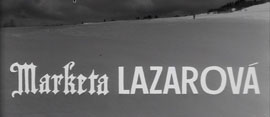 Czechoslovakia, 1967, black and white, 162 mins
Czechoslovakia, 1967, black and white, 162 mins
First, the superlatives. While I’m not competent to judge whether Marketa Lazarová really is the greatest Czech film ever made (as asserted by a poll of 100 Czech film critics in 1998), after three viewings I’m certainly confident enough to rank it alongside Bergman’s Virgin Spring (Jungfrukällan, 1960), Paradjanov’s Shadows of our Forgotten Ancestors (Тени забытых предков, 1964) and Welles’s Chimes at Midnight (1966), its only serious rivals when it comes to uncannily convincing, unforgettably cinematic renditions of the medieval era. Its action scenes recall Kurosawa at his most exuberant, its sweeping deep-focus widescreen images have more than a hint of Tarkovsky’s Andrei Rublev (Андрей Рублев), and Zdeněk Liška’s extraordinary score rivals anything in Ennio Morricone’s mid-1960s catalogue for its use of unexpected yet strangely appropriate vocal, percussive and electronic effects. Since none of the actors has any significant reputation outside their native countries (for all lead actress Magda Vašáryová’s current stature as a prominent Slovak politician and sometime Presidential candidate), they seem utterly authentic, as though František Vláčil simply dropped his camera into the middle of 13th-century Bohemia and just filmed what he saw.
The film starts with a series of white-shrouded landscapes, “frosts as passionate as the Christianity of that time”, says the faintly mocking narrator, who will later assume the role of God in a dialogue with one of his more hapless creations. A pack of wolves streaks across the screen, scavenging whatever they can, fresh human corpses an especial delicacy. The credits respect the family hierarchies so characteristic of the period, the principal dramatis personae highlighted by means of an ornate Germanic typeface against the plain sans-serif of the rest. In the film that bears her name, Marketa Lazarová herself appears somewhere near the bottom, as befitting the daughter of a man who himself is relatively low on the social scale. In a few deft shots, Vláčil has established one of his dominant themes: that of man’s relative insignificance in a landscape that’s unforgiving in both its weather and its fauna.
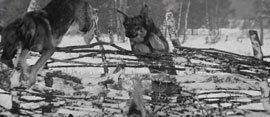
Marketa Lazarová is divided into two parts, titled ‘Straba’ and ‘The Lamb of God’. We learn towards the end of part one that Straba is a werewolf, not in the fantastical lycanthropic sense (the film has its supernatural elements, but they’re just as likely to be hallucinations on the part of the film’s more overwrought characters), but a man who has been condemned to live like a wolf as the worst conceivable punishment for his perceived sins. It’s a possibly tall tale, told by Kateřina, the Kozlík family matriarch, and it seems to refer to nothing in particular, aside from evoking an impression of bestial cruelty that pervades the film as a whole. With the exception of the nuns making up the holy order that Marketa wishes to join, the lives of these largely fur-clad people aren’t that far removed from animals, and to no-one’s surprise except its owner (the slow-witted holy fool Bernard), the lamb of the second half is quickly captured and eaten, its severed head bouncing unceremoniously down a hillside like a misshapen football.
The film is also subdivided into twelve “chapters”, each heralded by an opening title, in the same mock-heraldic typeface combination as the credits. On a first viewing, these might well prove essential for basic orientation, though their declamatory language is occasionally fuel for further head-scratching (“About the campaign which became a funeral, how the captain reflected on the death of his aide who fell at the hands of the sons of Kozlík before Oboriste. He is buried at Roháček.”).
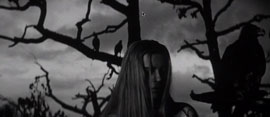
At the start of the film, the camera assumes the same crouching position as Mikoláš Kozlík, lurking in the undergrowth as his younger brother Adam (nicknamed ‘Jednorucka’ or ‘One-Armed’ – we gradually discover how he lost his left arm in a series of cryptic flashbacks) deliberately sets himself up to be accosted by a procession of Saxon noblemen. Within minutes one is dead, two are kidnapped and the party scattered, vowing a bloody revenge. The Kozlíks’ neighbour Lazar strategically robs the corpses, which Mikoláš erroneously believes will make him an ally, a mistake that nearly costs him his life.
But the overarching revenge theme, though it supplies the narrative with its backbone, ultimately plays second fiddle to Vláčil’s phenomenally detailed evocation of a medieval environment. The product of years of research (he even persuaded his cast to live like their characters), he explores their lives from top to bottom: the search for and storage of food in winter, and the care of horses, falcons and other livestock are just as important as the wider-ranging clashes between tribes and religions.
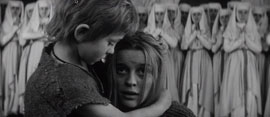
The two central female characters, Marketa Lazarová and Alexandra Kozlíková, represent Christianity and paganism – Marketa yearns for the safety and sanctity of the church (whose formal symmetry and elaborate architecture represents order in a world of otherwise unbridled chaos), while Alexandra turns a gnarled tree into a personal shrine, performs ritual sacrifices and disports herself naked in startlingly erotic alfresco sequences that would undoubtedly have fallen foul of the British Board of Film Censors had the film been submitted to them in 1967 (they might well have baulked at some of the violence too). She’s also having an incestuous relationship with her brother Adam, before she takes a shine to Mikoláš’s chief captive, the Saxon count’s son Kristián, the nominated Bishop of Hennau.
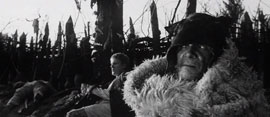
But the primary conflict is between the two main patriarchal figures, old Kozlík, and Captain Pivo (’Beer’), the King’s representative charged with avenging the opening assault and kidnap by Kozlík’s sons. They both have considerable forces at their disposal: Pivo’s being made up of professional soldiers, while Kozlík’s comprise members of his vastly extended family. With a long scar bisecting his balding pate, probably due to a badly-aimed blade, Kozlík is clearly not a man to be trifled with: retreating from a violent confrontation with Pivo, he is set upon by wolves, but extricates himself by stabbing one to death and letting the others feast on the corpse. He’s equally practical when his sons present him with two horses that they seized from the Saxons: he has the stallion slaughtered (since it’s more productive to eat it than feed it) while keeping the mare (presumably as a potential breeder).
Against this harsh backdrop, where even the spring seems deep-frozen, one wouldn’t expect great romances to flourish. Accordingly, the one that blooms between Mikoláš and Marketa is marked by initial violence (dragged away from her father’s house by her hair, she is subsequently raped and kept in fetters, though Mikoláš does at least make a point of disposing of the leg-irons favoured by his cackling father) and uneasy understanding – despite spending much onscreen time together, they have just one proper conversation towards the end. Dialogue in general is in short supply in a film where gesture speaks volumes – at one point, Adam even feigns dumbness when captured, the better to survive interrogation. The most garrulous character, Bernard, mostly comes out with quasi-Biblical gibberish (”the soliloquy of madmen”, notes a chapter heading), while Kateřina’s fount of folk wisdom is characterised more by weird atmospherics than any immediate relevance to the sit
uation at hand.
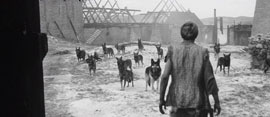
But who needs words when the pictures are so eloquent? Vláčil’s matchless eye, already much in evidence in The White Dove (Holubice, 1960), dominates almost every shot. Intricate compositions (Eisenstein and Welles seem the strongest visual influences) and camera choreography throw up one startling image after another, whether it’s the nuns symbolically releasing dozens of doves, Kristián walking unharmed through a pack of wolves, Pivo’s men bogged down in a swamp or Marketa’s silent yet potent encounter with a stag in the forest.
All this is enhanced by imaginative editing, with much use made of brief, sometimes near-abstract associative flashbacks, as well as conscious visual echoes – a pig is strung up for slaughter at an early stage, and we later glimpse, almost imperceptibly, a naked man awaiting the same fate. The densely layered soundtrack is particularly rich. Liška’s score, primarily consisting of a cappella vocals and complex percussion (he even built his own instruments, Harry Partch-style, to create the effect of a musical language developed centuries before the equal tempered scale), seems to arise organically out of a fusion of natural and artificial sounds: the cries of birds, animals and humans, the crackle of fire, the clash of metal against metal.
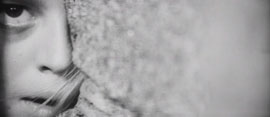
Vláčil’s thrillingly inventive film is a clear first choice for anyone wanting to explore either his work or Czech cinema outside the low-key humanism of the more familiar New Wave titles – or anyone who wants to discover a masterpiece that’s almost entirely unrecognised by the standard (Western) film history books. Marketa Lazarová is one of the most exciting rediscoveries in years – or rather discoveries, since it’s apparently had just three 35mm screenings in Britain to date, and the only way of seeing it legitimately on video has been via an unsubtitled VHS edition imported from the Czech Republic. Until now.
- Director: František Vláčil
- Producer: Josef Ouzký
- Screenplay: František Pavlíček, František Vláčil, based on the novel by Vladislav Vančura
- Photography: Bedřich Baťka
- Editor: Miroslav Hájek
- Design: Oldřich Okáč
- Sound: František Fabián
- Music: Zdeněk Liška
- Cast: Magda Vášáryová ()Marketa Lazarová); Josef Kemr (Old Kozlík); Naďa Hejná (Kateřina); Jaroslav Moučka (Jan); František Velecký (Mikoláš); Karel Vašíček (Jiří); Ivan Palúch (Adam-One-Armed); Martin Mrázek (Václav); Václav Sloup (Šimon); Pavla Polášková (Alexandra); Alena Pavlíková (Drahuše); Michal Kožuch (Lazar); Zdeněk Lipovčan (Jakub); Harry Studt (old Kristián); Vlastimil Harapes (young Kristián); Zdeněk Kutil (Reiner); František Nechyba (driver); Zdeněk Kryzánek (Captain Pivo, ‘Beer’); Zdeněk Řehoř (Sovička); Jan Pohan (Kornet); Otto Ševčík (monk); Vladimír Menšík (Bernard); Karla Chadimová (prioress); Pavel Landovský (Smil); Ladislav Považay (Burjan); Václav Kovařík (varlet Bohdan); Petr Sedlák (varlet Jakub); František Hlinovský, Jaroslav Mařán, Otto Lackovič (king’s soldiers)
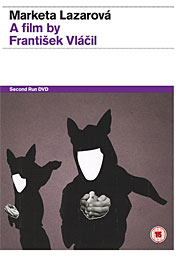
DVD Distribution: Second Run (UK), PAL, no region code. Interestingly, the DVD’s running time of 158 minutes translates to 165 minutes once PAL speedup is taken into account, making the film appear to be three minutes longer than the official theatrical running time. However, I have been unable to perform a direct comparison.
Picture: Despite minor quibbles, this is so much better than any of Facets’ Vláčil DVDs that there’s no comparison – and it’s currently the only English-subtitled DVD release anywhere in the world that does him justice. It would also be a shame if its very evident qualities were eclipsed by disappointment at the fact that it’s not a restoration from the original negative – this was mooted, but turned out to be unaffordable. By any reasonable standards, this is an excellent transfer: anamorphic, framed correctly in the original 2.35:1 Scope ratio, pin-sharp and with a pleasing dynamic range – the only issues on the debit side being some minor print damage on occasion (less noticeable with this film than many others because it’s so visually active), very occasional shimmer, and some shots seem a little too contrasty. However, as many other shots are perfectly lit this may have been intentional, and a friend who’s been lucky enough to see it in 35mm says that this was true of the big-screen version too. In terms of Second Run’s catalogue, this ranks alongside Intimate Lighting and The Party and the Guests as one of the very best transfers they’ve made of a 1960s film.
Sound: The soundtrack is presented in the original mono, and sounds fine – despite the unavoidable limitations of a 40-year-old recording, it copes well with a wide dynamic range, especially the soaring vocal highs and subterranean percussive rumblings of Zdeněk Liška’s score.
Subtitles: The white subtitles are clearly readable, idiomatic, typo-free and optional. Sensibly, they don’t obscure the original Czech intertitles, but present a well-paced line-by-line translation in the blank space at the bottom.
Extras: There are no extras on the disc (probably wisely, given the film’s length), but the booklet contains a substantial essay on the film and Vláčil’s career by Peter Hames, who has probably written more about both than anyone else in the English language.
Links
- České filmové nebe (in Czech)
- Česko-Slovenská filmová databáze (in Czech)
- Internet Movie Database
- Reviews: Central Europe Review (Peter Hames), plus Zuzana Slobodová’s challenge to the notion that it’s the best Czech film ever made.
- DVD Review: DVD Beaver (with screengrabs)
- Nostalgia.cz’s website about the film (in Czech, but copiously illustrated and with this English section about the possibility of an original-negative restoration)
- Second Run’s page about the DVD.
- DVD available from: Amazon.co.uk; MovieMail, Play.com